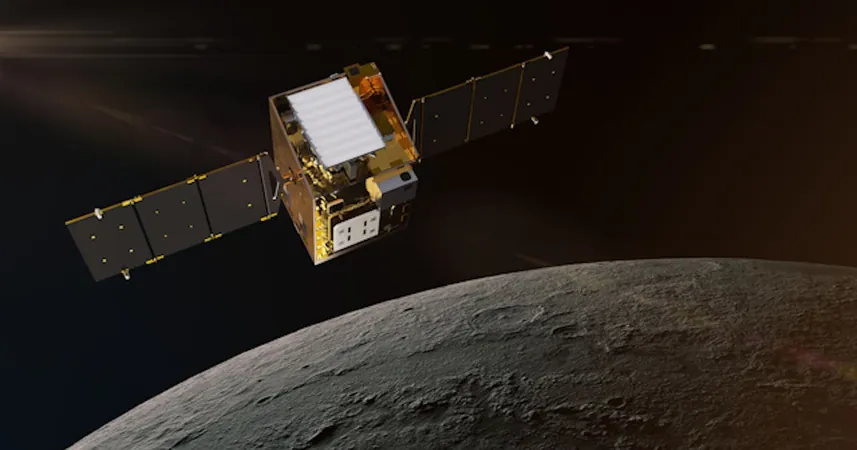
NASA’s Lunar Trailblazer: Paving the Way for Human Exploration of the Moon
2025-01-11
Author: Rajesh
NASA’s Lunar Trailblazer: Paving the Way for Human Exploration of the Moon
NASA is gearing up for a significant leap back to the Moon with its Artemis II mission, set to potentially launch no earlier than April 2026. This monumental expedition will see astronauts return to the lunar surface for the first time since the Apollo 17 mission in 1972, ushering in a new era of space exploration.
The Artemis II mission will utilize NASA's groundbreaking Space Launch System (SLS), a powerful rocket designed for deep space travel. Accompanied by a team of four, astronauts will voyage aboard the Orion spacecraft, a vehicle that has already proven its capabilities during the Artemis I mission when it successfully orbited the Moon and returned to Earth.
Before Artemis II takes flight, NASA is planning two preliminary missions to scout the lunar south pole, a region believed to contain essential resources needed for sustained human presence on the Moon. One of these missions, Lunar Trailblazer, is crucial for understanding how water exists and behaves on the Moon and other rocky celestial bodies.
Exploring the Moon’s Resources
Scheduled for launch in January 2025, the Polar Resources Ice Mining Experiment (PRIME-1) will carry sophisticated instruments aboard a lunar lander. This robotic mission includes the Regolith and Ice Drill for Exploring New Terrain (TRIDENT) and the Mass Spectrometer for Observing Lunar Operations (MSOLO). TRIDENT will probe up to 3 feet beneath the lunar surface to collect soil samples, while MSOLO will analyze their chemical makeup and water content.
Joining PRIME-1 will be the Lunar Trailblazer satellite, designed to work alongside the lunar lander. Using a revisited approach akin to a "rideshare" for space missions, both these projects will launch on a single Falcon 9 rocket, optimizing fuel use and costs.
Led by principal investigator and planetary scientist Bethany Ehlmann from Caltech, Lunar Trailblazer is part of NASA’s Small, Innovative Mission for Planetary Exploration (SIMPLEx) program. These missions aim to deliver pioneering scientific results at a reduced operational cost, with Lunar Trailblazer’s budget capped at around $80 million — still a fraction compared to traditional missions that can exceed $300 million.
The Power of Small Satellites
The development of small satellites, or SmallSats, has revolutionized space exploration. These compact, cost-effective devices allow for high-resolution data collection and can work together in multi-satellite formations, providing comprehensive scientific insight. Lunar Trailblazer represents a significant step in utilizing these technologies to understand the Moon's composition and history.
Unlocking the Moon’s Water Mysteries
The quest for lunar water has intrigued scientists for centuries. Early misconceptions dismissed the presence of water due to assumptions about the Moon's atmosphere. However, missions starting from the 1990s, including NASA’s Clementine, Lunar Prospector, and India’s Chandrayaan-1, have detected signs of water ice in permanently shadowed regions and unexpected finds in sunlit areas.
Lunar Trailblazer will further investigate the Moon’s water by utilizing its two advanced instruments: the Lunar Thermal Mapper (LTM) and the High-resolution Volatiles and Minerals Moon Mapper (HVM3). The LTM will map surface temperatures while HVM3 will analyze how lunar rocks reflect light, helping to distinguish between different states of water — whether it is liquid or ice.
By gathering data across the lunar day, which lasts 29.5 Earth days, the mission seeks to unveil how temperature variations influence the chemical state and distribution of water on the Moon’s surface.
Significance and Future Exploration
The origins of lunar water are believed to stem from three key theories: it could be ancient water embedded within the Moon since its formation, water brought by asteroids and comets, or even water generated by solar wind interactions. The findings from Lunar Trailblazer are poised to provide critical insights into these theories, contributing to our understanding of not only the Moon but also other planetary bodies in our solar system.
As we stand on the brink of a renewed lunar exploration era, Lunar Trailblazer promises to unlock the secrets of the Moon’s resources and is a pivotal step toward enabling future human habitation. The data gathered could transform the potential for extended missions, ultimately paving the way for long-term lunar settlements, making humanity's return to the Moon not just a visit but a vibrant new chapter in our exploration history.
Stay tuned as NASA sets its sights on this thrilling journey to reconnect with our nearest celestial neighbor!



 Brasil (PT)
Brasil (PT)
 Canada (EN)
Canada (EN)
 Chile (ES)
Chile (ES)
 Česko (CS)
Česko (CS)
 대한민국 (KO)
대한민국 (KO)
 España (ES)
España (ES)
 France (FR)
France (FR)
 Hong Kong (EN)
Hong Kong (EN)
 Italia (IT)
Italia (IT)
 日本 (JA)
日本 (JA)
 Magyarország (HU)
Magyarország (HU)
 Norge (NO)
Norge (NO)
 Polska (PL)
Polska (PL)
 Schweiz (DE)
Schweiz (DE)
 Singapore (EN)
Singapore (EN)
 Sverige (SV)
Sverige (SV)
 Suomi (FI)
Suomi (FI)
 Türkiye (TR)
Türkiye (TR)
 الإمارات العربية المتحدة (AR)
الإمارات العربية المتحدة (AR)